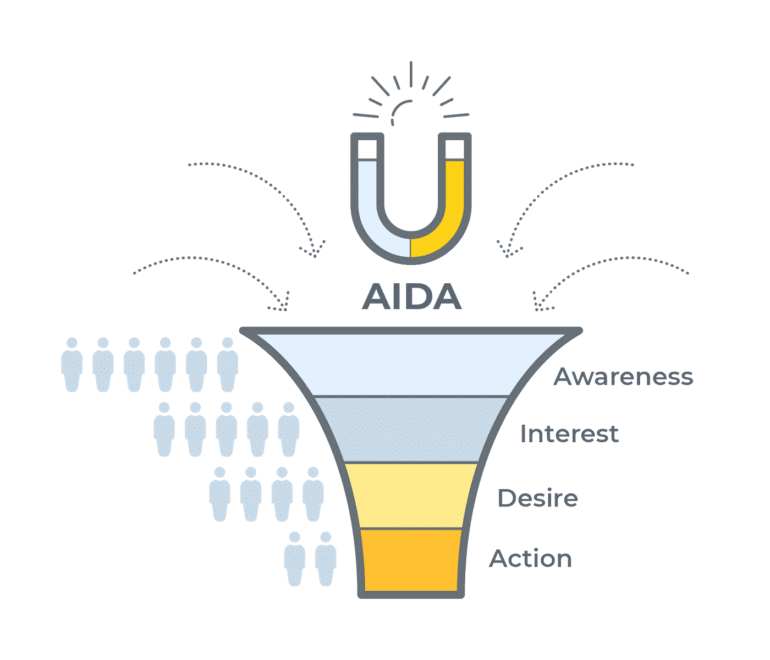Follow these five steps to dress your newsletters for success.

Table of contents
Beyond the subject line, how you format an email newsletter affects how readers engage — whether they keep reading, forward to a friend, or click your call to action. The format and content you pour in it should merge to support your marketing goals. For law firms, those goals usually involve influencing readers to learn more about you and, ultimately, convincing them to engage your services.
Follow these five steps to “dress” your newsletter for success.
How to Dress Your Law Firm Newsletter for Success
Assuming you know the main message you want to send your readers, a clear format conveys it best. Think “one theme, one column.” A one-column template makes it easier to skim and scroll on all devices, including mobile ones. Put the content in a logical order to help everyone read your newsletter, including the visually impaired. The classic “AIDA” advertising copywriting funnel is one model you can apply to your newsletter structure. The AIDA formula follows the steps of the customer journey: Awareness, interest, desire and action.

1. Make the Headlines
To stand out in your recipient’s inbox, write a specific, attention-getting subject line that hints at what’s inside. Most experts suggest you keep it to fewer than 50 characters, but your email open rates can suggest the best length. Generally, the shorter, the better the chance everyone will see it, especially in tiny preview windows.
Good headlines feature news, benefits, urgency, or have an emotional impact. Preview text can also entice opens and clicks.
Avoid clickbait-style subject lines to comply with attorney advertising guidelines and ethical promotion practices. And though few emojis grace law firm email headlines, they can enhance interest when they’re used in the proper context and at the end. But some studies show they might have an adverse effect, so use them sparingly.
Tip: The headline is the first thing people see, but you might want to save it for last because it could take more effort to write.
(For a deep dive into headline science, read “How to Write a Perfect Post.”)
2. Take It From the Top
Nielsen Norman Group (NNG) studies show readers tend to focus on the top-left of e-newsletters in an F-pattern that trails off toward the end. The top isn’t the place for throat-clearing or fluff. The NNG suggests you answer the “What?” and “Why?” questions here. Put the most important content in the header, such as an article headline, a call to action or your logo. This is also a spot for your social media icons.
Tip: Personalization, such as a greeting with your recipient’s name or tailoring the content to their interests, could be ideal. But it might not work well in law firm emails. Test to see what works best.
3. Find the Middle Ground
The body of your newsletter should build on the interest generated at the top. It might include details that persuade readers to attend a webinar or tout the benefits of a new product or service. You may add more informational copy, such as a paragraph or two from your latest blog post that links to the entire piece. Or, tell a story with a clear beginning, middle and end. Describe any videos, which can be secondary to text and images.
The users in the NNG study were also inclined to skim or glance at the overall content. Consider how your law firm newsletter scans. Are your paragraphs too chunky? (Aim for one to three lines per paragraph.) Is there enough white space to let the content breathe? This is also a good spot for an eye-catching, web-optimized image. Beware, however, that too many graphics could increase the load time. Keep your content clear and concise to ease reading.
Tip: To maintain busy readers’ attention, 300 words or less is an acceptable word count for this section.
(For more writing tips, read “5 Steps for Writing Engaging Email Newsletters.”)
4. Wrap It Up!
Your closing should build on the desire created in the prior step and urge action. Summarize your best takeaways and lead into a call to action such as a link to a landing page or “Contact us” page. Campaign Monitor reports that a button instead of a text link can boost conversion rates by as much as 28%. As Campaign Monitor also suggests, you might say “farewell” or show your gratitude.
Tip: This is another place to include your social media sharing buttons and website address.
5. End Well
In the newsletter’s footer, add information that complies with the CAN-SPAM Act (U.S. and Canada) and GDPR (Europe) laws. Per the CAN-SPAM Act, you must place your physical address and unsubscribe options here. You may also add copyright information below it.
Unlike an email marketing campaign, HubSpot suggests newsletter content should be 90% educational and 10% promotional. Considering the potential for lost interest, follow an inverted pyramid format. Move the most critical information to (or near) the top. While you might want to place calls to actions in several spots in the newsletter, beware of creating confusion by designing a primary call.
Unlike other marketing tools, law firm newsletters linger in inboxes and have a longer promotional lifecycle. Well-structured and well-written content increases your odds of leaving a message that will stay with readers — and bring in more business.
“Related: Should You Use ChatGPT in Your Law Firm Marketing?“
Image © iStockPhoto.com.

Sign up for Attorney at Work’s daily practice tips newsletter here and subscribe to our podcast, Attorney at Work Today.
















